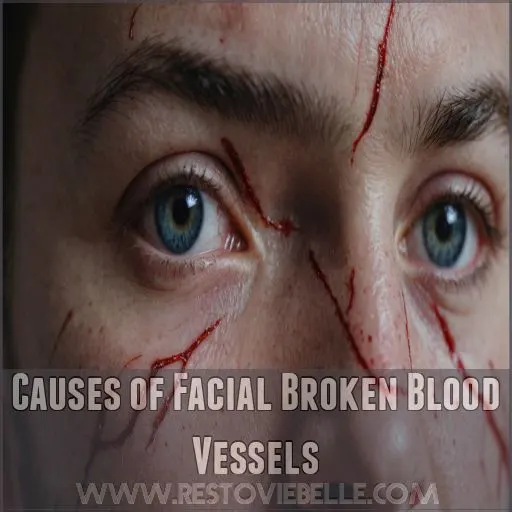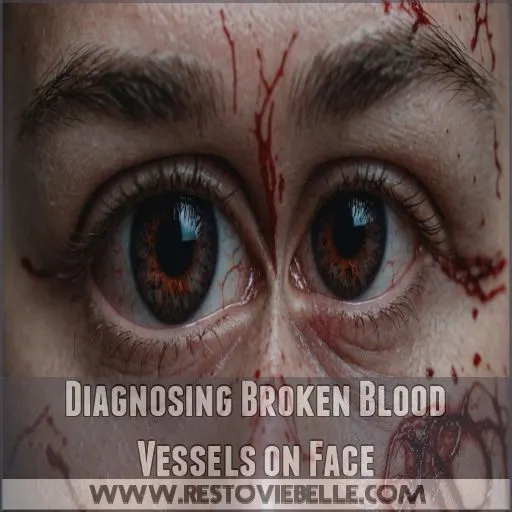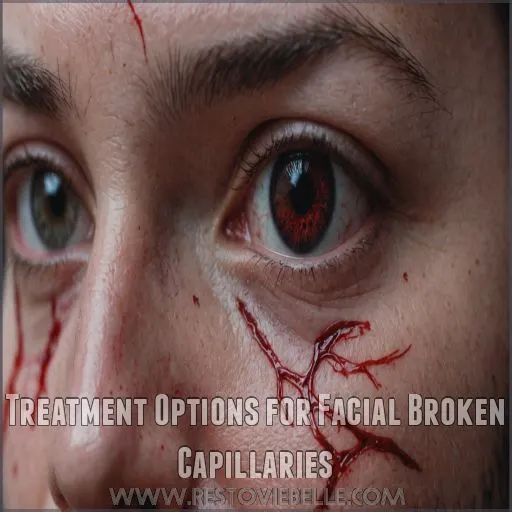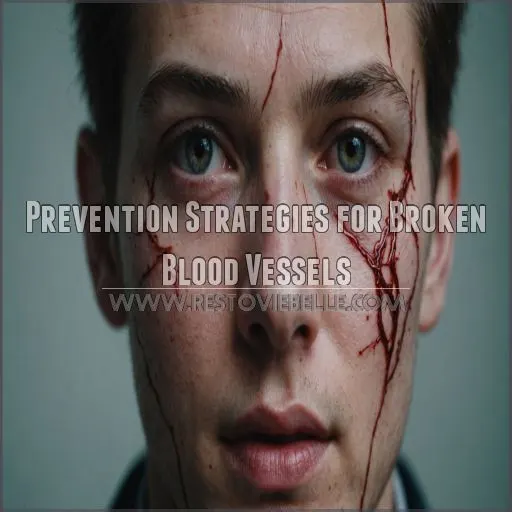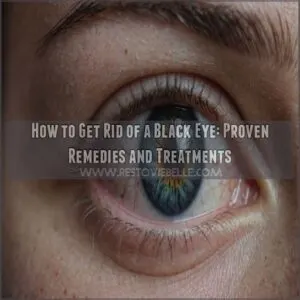This site is supported by our readers. We may earn a commission, at no cost to you, if you purchase through links.

These little red lines or dots are super common, often caused by a mix of genetics, sun exposure, and even sneezing. While they may not be harmful, they can be a real bummer to look at.
The good news is there are treatments like laser therapy and home remedies that can help minimize their appearance. And if you’re really bothered, a visit to the dermatologist can give you even more options.
Stay tuned for more tips on managing those tricky broken blood vessels!
Table Of Contents
- Key Takeaways
- Identifying Broken Blood Vessels on Face
- Causes of Facial Broken Blood Vessels
- Risk Factors for Developing Broken Capillaries
- Diagnosing Broken Blood Vessels on Face
- Treatment Options for Facial Broken Capillaries
- Prevention Strategies for Broken Blood Vessels
- Long-Term Management of Facial Broken Capillaries
- Frequently Asked Questions (FAQs)
- How do you get rid of broken blood vessels on your face?
- What causes burst blood vessels in the face?
- How long does it take for blood vessels to heal in your face?
- Are broken blood vessels serious?
- Can stress cause broken facial blood vessels?
- Do sunburns lead to facial broken capillaries?
- Are there dietary changes to reduce facial redness?
- What skincare products aggravate facial blood vessels?
- Can cold weather affect broken blood vessels on face?
- Conclusion
Key Takeaways
- You’re not alone with those red lines on your face, fondly called spider veins. They’re like nature’s little abstract art projects, often fueled by genetics, sun exposure, or even a good sneeze fest.
- Think of laser therapy and intense pulsed light treatment as your magic wand to zap away those pesky blood vessels. If you’re more of a DIY type, horse chestnut and aloe vera are gentle home remedies worth trying.
- Prevention is like brushing your teeth – routine. Slap on sunscreen, manage stress as if you’re in a zen garden, and watch out for those spicy food-induced blushes.
- If those tiny red lines become painful or look like they’re teaming up to form a map, it’s time to see a dermatologist. They’ve got the detective skills to dive deeper and sort things out.
Identifying Broken Blood Vessels on Face
Ever noticed those tiny red lines on your face that look like a spider’s web?
You’re not alone – these are broken blood vessels, and knowing how to spot them is the first step in tackling this common skin concern.
Appearance and Characteristics
Ever noticed tiny red lines on your face that look like a spider’s web? Those are broken blood vessels, also known as spider veins . They’re like nature’s abstract art on your skin, but not always welcome.
- Color: Reddish-purple patches or tiny red dots
- Size: From pencil eraser to quarter-sized spots
- Texture: Flat against your skin, not not notdots
Common Locations on Face
Now that you can spot those pesky red lines, let’s map out where they love to set up camp on your face.
Your nose is prime real estate for broken capillaries, followed closely by your cheeks and chin. Don’t be surprised to find them partying around your eyes or forehead too.
These tiny troublemakers are like unwanted guests at a house party – they show up wherever they please, and are often considered unwanted guests and tiny troublemakers.
Differentiating From Other Skin Conditions
You’ve spotted those pesky red lines on your face, but hold your horses! Before you jump to conclusions, let’s play detective and distinguish broken blood vessels from their sneaky look-alikes. It’s like a game of "Spot the Difference" for your skin.
- Spider veins: Tiny red lines spreading like a delicate web
- Rosacea: Persistent redness with visible blood vessels
- Acne: Red bumps with possible whiteheads or blackheads, no
- Eczema: Dry, itchy skin that may appear reddish
Remember, proper identification is key to getting the right treatment, whether it’s laser therapy for spider veins or a different approach for other conditions
When to Seek Medical Attention
While broken blood vessels are often harmless, some signs warrant a doctor’s visit.
Watch for pain, persistent bleeding, or worsening discoloration. If you’re playing "connect the dots" with spider veins on your face, it’s time to seek help.
Head injuries or sudden pressure changes can be red flags too.
Don’t let environmental irritants be the puppet master of your skin health, especially in the case of red flags like persistent bleeding.
Causes of Facial Broken Blood Vessels
Wondering why those pesky broken blood vessels keep popping up on your face?
From genetics to lifestyle choices, here’s a closer look at what’s causing those little red lines to make an appearance.
Genetic Factors
Genetic factors are like that quirky family trait nobody asked for but got anyway.
Your family history might be nudging those pesky broken blood vessels onto your face. Genetic predisposition and hereditary influence are at play, and you’ve got company in gene mutations land.
Genetic testing can shine a light, even when vitamin C, vitamin A, and lifestyle habits pitch in to help.
Environmental Triggers
Imagine your face as a battleground, constantly facing environmental triggers like sun exposure and pollution. Protecting it is key.
- Sun Exposure: Wear sunscreen daily to protect against harmful UV rays and skin cancer preventing skin cancer
.
- Extreme Heat: Avoid saunas and hot tubs to prevent vessel dilation.
- Cold Exposure: Wrap up warmly to shield sensitive skin.
- Pollution: Cleanse your face regularly to remove irritants.
Medical Conditions
Unwelcome surprises sometimes look like patches of redness from medical conditions.
Rosacea loves to flare up, and eczema might just add to the mix of broken blood vessels on your face.
Those little lines can connect with acne, psoriasis, or even skin cancer.
Crafting a customized treatment plan with ingredients like horse chestnut and aloe vera could be your winning ticket.
Lifestyle Habits
While medical conditions may contribute to facial broken blood vessels, your lifestyle habits can be just as impactful.
Regular alcohol use, a poor diet, and lack of exercise can stress your skin.
Throwing stress and sleep deprivation into the mix? It’s a recipe for visible veins.
Try witch hazel or apple cider vinegar as home remedies to help ease the redness.
Physical Trauma
Facial trauma can be quite the party crasher, leaving unsightly broken blood vessels in its wake. You’ll find these culprits from accidental bumps or sports injuries.
- Minor injuries: Even a small bump can leave a mark.
- Sports injuries: High-impact sports are notorious.
- Impact on blood vessels: Direct hits cause visible damage.
Risk Factors for Developing Broken Capillaries
Ever wonder why some people seem more prone to broken capillaries on their face?
From skin type to those pesky hormonal changes, understanding the risk factors can feel like piecing together a skincare jigsaw puzzle.
Skin Type and Sensitivity
Your skin and sensitivity can put you at higher risk for developing broken blood vessels on your face.
If you have fair, sensitive skin or a condition like rosacea, you’re more prone to these unsightly spider veins.
To combat this, consider using a gentle face mask that incorporates soothing botanicals like aloe vera and chamomile, which can calm inflammation and promote healing Soothing Rosacea Masks.
Protecting your skin from sun exposure and irritants is also essential to keep your complexion clear and healthy.
Hormonal Fluctuations
Hormonal fluctuations can feel like riding a roller coaster.
During pregnancy or menopause, your hormones might spike and lead to those pesky broken blood vessels on your face.
Starting or stopping birth control can trigger similar effects.
Plus, thyroid issues and stress don’t just test your patience—they can test your skin too.
Occupational Hazards
Finding yourself in hot water—literally—from construction work or prolonged standing can lead to broken capillaries on your face.
Sun exposure’s no picnic, either; it’s like an invisible boxing match for your skin.
Add heat stress or heavy lifting, and you’ve got a recipe for trouble. Protect your skin and play it safe to avoid this occupational hazard.
Chronic Health Issues
Living with chronic health issues is like steering a ship through stormy seas.
Conditions like diabetes or hypertension might increase your risk of broken blood vessels on your face. Keep your medical history handy and consider lifestyle impacts.
- Diabetes increases capillary fragility.
- Hypertension adds pressure to vessels.
- Chronic venous insufficiency causes vein damage.
- Treatment options include medications and lifestyle changes.
Diagnosing Broken Blood Vessels on Face
Spotting broken blood vessels on your face isn’t just about seeing those tiny, red web-like lines; a trained eye knows a good checkup involves a physical examination, sometimes even imaging tests.
Don’t worry, it won’t feel like a science fair project, and your doctor will guide you through diagnosing them quickly and effectively.
Physical Examination Techniques
Now that you’re aware of the risks, let’s look at how doctors identify the problem. They use visual inspection first, checking for those pesky spider veins.
Palpation follows, where they gently press the area. Transillumination offers more insight. For thoroughness, Doppler ultrasound and dermoscopy join the squad.
Here’s a quick summary of the techniques used:
| Technique | Purpose | Comment |
|---|---|---|
| Visual Inspection | Initial assessment | Like playing detective |
| Palpation | Confirm presence | Gentle pressure test |
| Transillumination | Light examination | Light show, anyone? |
Imaging Tests
If the doctor suspects broken blood vessels on your face, they may order imaging tests like CT scans, MRIs, or angiograms. These can reveal the size, location, and shape of the damaged vessels.
Some key tests include:
- Computed Tomography (CT) Scan
- Magnetic Resonance Imaging (MRI)
- Cerebral Angiography
- Doppler Ultrasound
These advanced imaging techniques provide a clear picture to guide treatment and prevent complications.
Biopsy Procedures
While it might sound intimidating, a facial biopsy is your detective tool to uncover mysterious blood vessels. Depending on the type, it could involve a tiny needle or a small incision. Risks? Minimal.
Preparation includes stopping blood thinners. Drinking plenty of water, as with any skin health issue, is also essential, as it helps hydrate cells and reduce dehydration signs, and even improves skin health overall by enhancing your skin care routine with Hydrating From Within.
Additionally, consuming foods rich in omega-3 fatty acids, such as fish oils and berries, can help fight inflammation.
Results give clarity, usually within days. Recovery’s a breeze—no downtime! Think of it as a necessary pit stop for skin health.
Differential Diagnosis Considerations
Diagnosing broken blood vessels on the face is like sorting through life’s mysteries.
You need to differentiate between Rosacea, Telangiectasia, and those pesky Spider Veins.
Keep your eyes peeled for Purpura and Facial Flushing, too. Finding the root cause isn’t just about appearances; it’s like solving a puzzle, making sure nothing hides in plain sight, and solving a puzzle.
Treatment Options for Facial Broken Capillaries
So you’re dealing with those pesky red spider veins on your face and wondering how to banish them for good?
From laser zaps to simple home remedies, there are plenty of ways to tackle broken capillaries and reclaim clear skin.
So let’s explore what might work best for you to tackle broken capillaries.
Laser Therapy Techniques
So you’ve confirmed those pesky red marks are broken capillaries.
Enter laser therapy, your magical wand waving away imperfections. Various laser types target hemoglobin with pinpoint precision, zapping those red spots.
While it’s quick and effective, keep risks in mind. Compare costs, check recovery times, and expect impressive long-term results.
Remember, your smooth skin is just a beam away! .
Intense Pulsed Light (IPL) Treatment
Laser therapy has its perks, but let’s talk about Intense Pulsed Light (IPL) treatment for those pesky broken capillaries. It’s like hitting the reset button on your skin without a time machine!
Expect improvements with:
- IPL Treatment Costs: Investment in your skin.
- IPL Treatment Side Effects: Temporary redness, a small price.
- IPL Treatment Recovery: Quick bounce back.
- IPL Treatment Results: Visible clarity boost!
Sclerotherapy Procedures
While IPL shines brightly in treating facial veins, sclerotherapy steps in with its own flair.
Ideal for body veins but rarely used on the face due to risks, it injects a saline solution to collapse veins.
Recovery involves wearing compression stockings. Costs can vary, so exploring sclerotherapy alternatives is wise before taking the plunge.
Natural Remedies and Home Care
Wondering how to tackle those pesky broken blood vessels on your face?
Try these natural remedies: 1. Apply apple cider vinegar with a cotton ball to reduce redness.
- Use topical horse chestnut to improve vein health.
- Wash your face with warm, not hot, water.
- Soothe with aloe vera gel.
These gentle options may help minimize the appearance of spider veins.
Prevention Strategies for Broken Blood Vessels
You don’t need a superhero cape to tackle broken blood vessels on your face—just a bit of savvy protection and care.
Think of sun protection, a good skincare routine, and a dash of stress management as your trusty allies in keeping those troublesome veins at bay.
Sun Protection Measures
Luckily, you can prevent broken blood vessels with smart sun protection! Choose the right sunscreen types for your sun-sensitive skin, such as broad-spectrum SPF 30 or higher.
Wide-brimmed hat styles add flair while offering shade. Limit sun exposure during peak hours to reduce skin cancer risks.
Remember, your skin’s like a cherished old book—protect it from the sun!
Skincare Routines
Anyone can enhance their skincare routine to prevent broken blood vessels on your face.
Tweak your regimen with these key strategies:
- Apply vitamin C serums with tetrahexyldecyl ascorbate.
- Use broad-spectrum sunscreen to protect against UV rays.
- Incorporate professional treatments like LED light therapy for long-term results.
Little changes can make a world of difference!
Lifestyle Modifications
With skincare routines offering a base, lifestyle modifications keep broken blood vessels at bay. Focus on the five pillars: Diet, Exercise, Sleep, Stress, and Alcohol.
Stay hydrated, exercise regularly, and get good sleep. Remember, moderation in alcohol is key. Balance in these areas can keep your skin looking its best!
| Aspect | Action | Benefit |
|---|---|---|
| Diet | Stay hydrated | Maintains skin health |
| Exercise | Regular activity | Improves circulation |
| Sleep | Prioritize rest | Reduces skin stress |
Stress Management Techniques
Managing stress can keep your skin looking its best. Imagine stress management as your secret weapon against those pesky broken blood vessels!
Try these techniques:
- Mindfulness and Meditation help calm your mind and skin.
- Deep Breathing and Progressive Relaxation ease tension away.
- Yoga balances your body and spirit.
Embrace these practices—your skin will thank you!
Dietary Considerations
Skipping the stress of daily life can help, but have you considered what’s on your plate?
Embrace Vitamin C-rich foods to fortify capillaries and say goodbye to spicy foods.
Hydrate well, and keep alcohol consumption low—it’s not worth the red cheeks!
Watching what you eat can be your ace in the hole against broken blood vessels.
Long-Term Management of Facial Broken Capillaries
Dealing with those pesky broken blood vessels on your face doesn’t have to be a lifelong struggle.
From maintenance treatments to clever camouflage techniques, we’ll walk you through the long-term solutions to keep those unsightly capillaries at bay.
We’ll cover everything to help you keep those broken blood vessels under control.
Maintenance Treatments
To keep broken capillaries at bay, start with smart lifestyle changes. You might be tempted to skip sunscreen on a cloudy day, but don’t let the UV rays fool you.
Add home remedies and topical creams to your routine, including those with niacinamide and ceramides that boost skin hydration and improve skin elasticity. For a professional touch, laser treatments can help.
Regular use of ceramide-rich moisturizers can also support your skin’s natural barrier function. Remember, you’re in control of your skin’s story.
- Use sunscreen daily
- Explore soothing topical creams
- Consider professional laser treatments
Monitoring for Recurrence
Now, let’s keep an eye on those cheeky capillaries!
You’ll want to spot new triggers, like lifestyle changes or sun exposure, that might cause a reoccurrence.
Regular check-ins with your dermatologist can help track improvements and treatment effectiveness.
Think of it as your skin’s way of asking for a little extra love and attention—before it’s too late with some lifestyle changes.
Addressing Underlying Causes
Tackle those broken capillaries by addressing what’s under the hood. Focus on long-term solutions like managing rosacea, limiting sun damage, and moderating alcohol. It’s like giving your skin a spa day from the inside out!
- Rosacea management
- Avoid sun exposure
- Monitor alcohol use
Remember, understanding hormonal changes and genetic predisposition can also lead to smoother days ahead.
Cosmetic Camouflage Techniques
Give your skin a break and jump into camouflage makeup. Learn the art of concealer application.
A touch of green tones works wonders to neutralize redness, making those broken capillaries vanish like a magician’s trick.
With the right makeup tips, you’ll feel like a pro, taming those capillaries and gaining control over your daily look .
Psychological Impact and Support
Dealing with facial broken blood vessels can sometimes feel like a never-ending battle on your self-esteem.
It’s essential to focus on practical coping mechanisms:
- Boost body image with positive affirmations.
- Tackle social anxiety by seeking therapy or support groups.
- Build emotional support networks with friends and loved ones.
Remember, you’re not alone; many face similar challenges and succeed.
Frequently Asked Questions (FAQs)
How do you get rid of broken blood vessels on your face?
To reduce broken blood vessels, try laser therapy or intense pulsed light treatments for deeper issues.
At home, wash your face with warm water and avoid extreme heat.
Consult a doctor for personalized advice.
What causes burst blood vessels in the face?
Old habits die hard, so watch out for sun exposure, genetics, aging, and rosacea.
These sneaky culprits can weaken your blood vessels.
Keep a hat handy and protect your skin like it’s your most prized possession.
How long does it take for blood vessels to heal in your face?
Blood vessels in your face, like broken capillaries, can heal themselves within 3-6 months if lightly damaged.
Persistent ones may need treatments for lasting improvement. Think of these treatments like giving your skin a helpful boost (Source).
Are broken blood vessels serious?
Seeing red lines under your skin can feel like spotting storm clouds on the horizon.
They’re more of a cosmetic hiccup, often harmless and easily treatable if desired (Source).
Can stress cause broken facial blood vessels?
Stress can indeed lead to broken facial blood vessels, as it can trigger rosacea—a condition known for causing such vessels.
Managing stress through relaxation techniques might help control this pesky skin issue.
Do sunburns lead to facial broken capillaries?
Absolutely, sunburns can lead to broken facial capillaries.
The UV rays damage blood vessel walls, causing them to dilate and become visible under the skin.
Protecting your skin and using targeted treatments can help minimize this sun-induced skin damage. (Source)
Are there dietary changes to reduce facial redness?
Picture your diet as a colorful canvas.
Add dark fruits like berries and leafy greens to reduce facial redness.
Cutting spicy foods and alcohol helps too.
It’s like painting over irritation with calming, nourishing brush strokes .
What skincare products aggravate facial blood vessels?
Some skincare products can stir up trouble for your facial blood vessels.
Steer clear of harsh scrubs, hot water, or steroid creams.
They’re known to irritate and aggravate your skin, making redness and visible veins worse.
Can cold weather affect broken blood vessels on face?
Cold weather can make broken blood vessels on your face more noticeable by narrowing blood vessels, reducing blood flow and causing flushing.
Protect your skin with scarves or balaclavas, and use gentle skincare products to minimize irritation.
Conclusion
Think of broken blood vessels on your face as nature’s way of painting abstract art, similar to those dark spots caused by excessive sun exposure sun’s damaging effects
.
While they mightn’t be the masterpiece you wanted, understanding their causes and exploring treatments can help you reduce their visibility.
Whether it’s laser therapy or home care, options abound.
Prevention is key—embrace sun protection and stress management to keep your canvas clear.
And remember, a dermatologist can offer guidance to tailor solutions that suit your skin’s unique needs.


